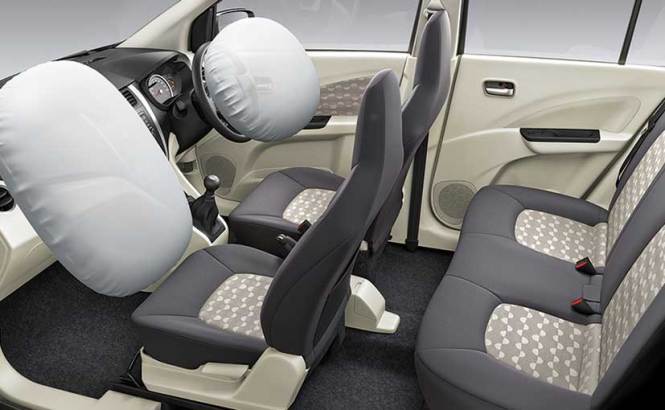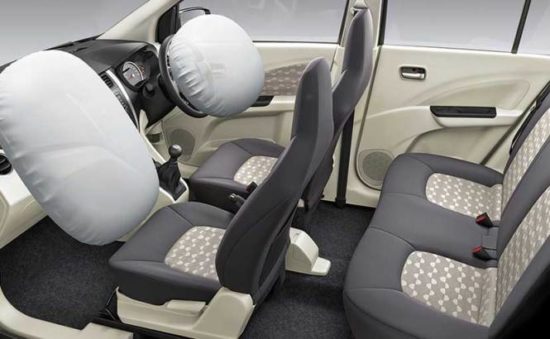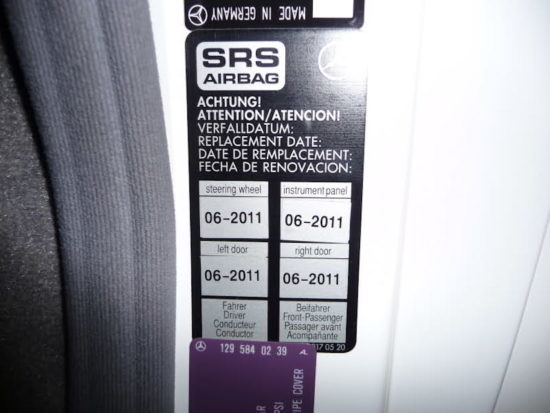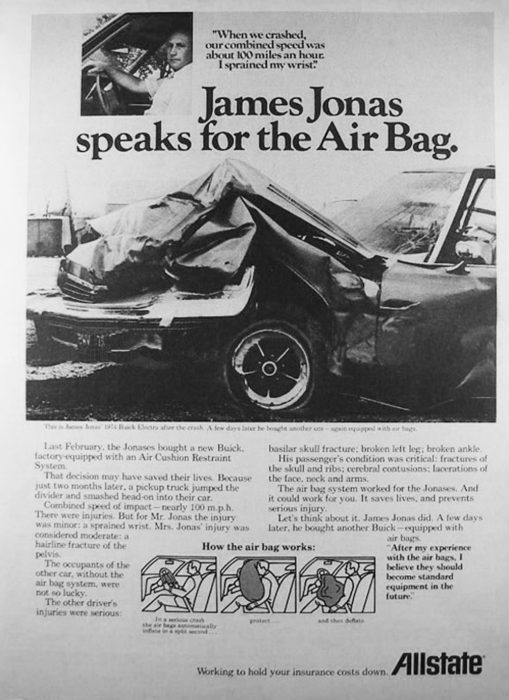by Wallace Wyss –
Remember when air bags were announced? Oh, we would still have seat belts, and there would still be a law to buckle them but the saving grace of every serious accident would be the air bag.
Now the air bag has turned into our enemy.
The problem is faulty inflators. They may inflate even when there is no accident or worse in an accident, you are hoping for a bag to absorb the energy but as the bag opens along with it comes enough shrapnel to look like you were attacked by people with machetes.
It wasn’t only Japanese companies like Honda, Toyota, Nissan, Mazda, and Subaru that had Takata airbags. So did Ford, Mercedes and Pontiac. Two years ago the recall to put in better bags was 19 million vehicles in the U.S., the most massive recall in auto history but it’s no doubt a lot more now.
THE PLUS SIDE
OK, the pro-air bag people can point to the NHTSA (National Highway Traffic Safety Administration) statistics of over 37,000 lives saved between their initial adoption in 1975 and 2012. But that statistic is now being slowly crept up by the Bogie of bad air bags that kill you.
In the beginning there was the worry people would depend solely on the bags and not buckle their seatbelts. So when they went into cars we still had the belts. Benson and Bingham, car accident attorneys based in Nevada, have something to say about seatbelts:
“After dropping down into the 200s during the years of 2009 to 2013, the death toll has been steadily climbing since then. Part of the reason for the increase, the article notes, is a booming population in recent years and the failure for vehicle occupants to buckle up their seat belts.”
The idea of the air bag is to soften the blow and spread it out so, say, the steering wheel doesn’t cave in the driver’s ribs.
THE PARTS
There are six ingredients to a system: an accelerometer; a circuit; a heating element; an explosive charge; and the bag itself.
When the accelerometer detects an impact a spark is sent to ignite the propellent, usually solid pellets of sodium azide (NaN3), which explodes. The explosion produces nitrogen gas (N2~) at a speed of 200 mph, in 1/25 of a second.
THE INFLATOR IS THE VILLAIN
Sounds good, right?
But the problem with Takata’s airbags is that the inflator—the metal cartridge packed with propellant wafers—sometimes ignites and when the housing ruptures, pieces can fly through the bag. And who’s at the soft end of the bag? The driver and passengers.
One thing the engineers didn’t plan for, and I say shame on then for not devising a way to test for it, was what cumulative years of exposure to high heat and humidity in certain areas of the country (particularly Texas and Florida) would do to the propellant wafers. The ammonium nitrate propellant—a chemical that is sometimes used in making bombs—then burns too hot and too fast, creating pressure the metal housing was not designed to contain.
A SAD SOLUTION THAT NOBODY LIKES
So here’s the problem. There are millions of cars with these faulty air bags. Takata has tried to replace some with updated ones but you have to ask, in some of these cars, you’re talking the existence of thousands of $1000 used cars with 200,000 miles on them found at the back of a used car lot. A car that has gone through ten owners.
How far should the manufacturer’s responsibility extend? I say set limits either mileage wise, say 100,000 miles or model year wise, say five years. Otherwise all those old beat up cars are still accumulating mileage, some of them heading for the air bag rupture. But that will only apply to cars being built now, unless you could force through legislation to make it retroactive.
More effective would be removal of the air bags and replacement with good old-fashioned seat belts. I wouldn’t mind taking my 2015 car in and having seat belts and shoulder harnesses and the air bags taken out, but I would want them NASCAR-style wide seat belts and two over the shoulder straps. And then you would have to reinforce the floor or they would just pull out.
We are talking hundreds of dollars per car. The women won’t want to wear them because the belts will get their clothes dirty. But we have to have an emergency exit from this situation, so to speak, because let’s face it, the automakers weren’t looking down the road far enough when they went with air bags. They weren’t looking at faulty performance due to materials degrading.
They thought they would be good forever. They made us think that (I even remember TV commercials from Chrysler touting air bags).
They were wrong. Dead wrong.
MERCEDES WARNED BUYERS REPLACEMENT NEEDED DOWN THE LINE
Surprise No. 1: when I posted some of these thoughts on a website Ferrarichat.com, one forumite said that Mercedes used to post information on the door jamb of some cars to warn owners that the air bags have a shelf life, that they need to be replaced periodically.
I never read anywhere, back when air bags were being praised for their life saving ability, that air bags need to be replaced periodically. And I already know that my seat belt suggestion has the problem that the cloth in seat belts age so they need periodic replacement.
JAIL TERMS FOR AUTO EXECS
On Ferrarichat someone also mentioned the NHTSA didn’t know that the air bags weren’t for women and children, anyone smaller than the average size male dummy they were using in tests, but this anonymous writer implied that was a lie–that the NHTSA was told Oldsmobile had found that out. But they deployed them without warning the public.
Which brings us around to the modern world of having auto executives face the truth and being brought to justice. Volkswagen executives are still feeling the heat from making at least 10,000,000 diesels with software that would cheat the emissions tests. Martin Winterkorn, once the CEO, has been charged in Germany (don’t forget, VW is partially government owned) along with four other executives.
I think what we need is a similar congressional hearing in the U.S. about air bags and grilling the executives. This would include some checking out of the executives email (even though the airbags precedes the advent of email) to see if they, internally, knew they were building and selling flawed devices.
I think we will find that there were auto executives who knew that air bags had a time limit, but never bothered to include that information in what they told the public. I think there were executives that took bribes to go for a certain brand because it’s still inexplicable to me that firms with the highest standards still went for a flawed product (such as Mercedes, but to their credit Mercedes-Benz uses Takata driver-side and passenger-side airbags in many vehicles and, is recalling vehicles which use the affected airbags.)
At the present I cannot recall any auto executive in the US being brought to trial for lying about some new feature that turned out to be deadly. What gives auto executives a special pass?
And while we are working on an alternative to air bags, we need a mandatory NO RESALE on all those vehicles that haven’t had the bags replaced.
Let us know what you think in the Comments.
Wallace Wyss
THE AUTHOR: Wallace Wyss is the co-host of Autotalk, broadcast from KUCR FM Riverside, California.
Support My Car Quest – Click Here







So your main source for all this paranoia is ”someone on Ferraris chat once posted this.” ?
Richard,
You may want to read some of these news articles: https://www.npr.org/tags/358652231/takata
“Honda Recalls 1.1 Million Vehicles After Air Bag Injures Driver”
“Overwhelmed By Air Bag Troubles, Takata Files For Bankruptcy Protection”
“Takata To Pay $1 Billion Over Air Bag Fraud; 3 Executives Criminally Charged”
plus many more…
There are auto engineers and designers on that ref. source. World class engineers. I could research it further but I had to write something now because, in researching autonomous cars, I keep running up against do-gooders who discount the deaths we’ve already had, willing to take a few deaths in exchange for a feature that ithey claim is for the greater good. It’s the air bag scenerio all over again. And are you implying the Mercedes metal tag is faked? There shoild be a tag like that on all cars.
Thanks for this coverage, Wallace. I knew the essentials but not the details. I received a stack of recall notices about my car’s Takata airbag but when I went in they didn’t have parts. Thanks, folks. Then I knew I had a ticking time bomb in my face but couldn’t fix it. I finally got it swapped but they didn’t provide any details as to the improvements made or the lifetime of the new device.
I always wear my seatbelt and if you have working retractors and wear clean clothes, they shouldn’t get dirty (so there’s really no excuse to skip wearing them). I highly recommend full belts (as you recommended), given a bad experience with older GM belts — the shoulder belt was messed up — and ending up needing serious medical attention. The ideal is wide, full, strong belts and a helmet, but a latched 3-point belt is a great baseline.
I have never been able to get a quote out of my mind from Automotive News in the 70’s where GM had proudly announced that they had gotten the air bag technology to the point it was only slightly killing the crash test dummies…
Talk about articles that stick in your mind, I remember an old Car & Driver story about Pat Bedard, one of their editors, said car engineers carry around 3″ x 5″ cards with the failure rate of parts they designed, hoping the rate will be below 15%. I am a voice in the wilderness saying this is not acceptable with air bags. If they can’t get them foolproof, do we–the public–want to accept that 15%? With air bags it may be below that, but as the Takata bags already out there get older, apparently they become more dangerous.
Wallace has brought up an important subject.
I know when I bought a new car 2 years ago (Porsche Mecan) I was assured that it did not have a Takata air bag. If it did I would not have bought it.
I also double checked to be sure my other cars with air bags were not on the recall list.
With everything in life there are risks and the question is the risk of injury higher with a Takata air bag or with no air bag and seat belts?
Vehicles made by 19 different automakers have been recalled to replace frontal airbags on the driver’s side or passenger’s side, or both in what NHTSA has called “the largest and most complex safety recall in U.S. history.” The airbags, made by Takata, were mostly installed in cars from model year 2002 through 2015. Some of those airbags could deploy explosively, injuring or even killing car occupants.
Visit https://www.safercar.gov/ to check the recall status of your vehicles.
Takata may be the tip of the iceberg. After the article was posted, new worries are about the controllers failing to work. Every day the idea of the air bag seems to have more downside than upside….
https://www.usatoday.com/story/money/cars/2019/04/23/nhtsa-airbag-investigation-fiat-chrysler-honda-hyundai-toyota/3547909002/